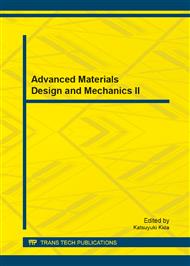[1]
A. Alamdari, A. Jahanmiri, and N. Rahmaniyan, Mathematical modelling of the urea prilling process, Chem. Eng. Comm., 178, (2000) 185-198.
DOI: 10.1080/00986440008912182
Google Scholar
[2]
N. Rahmaniyan, A. Alamdari, A. Jahanmrir, Modeling of the urea prilling tower, 3rd World Congress on Particle Technology, Brighton, UK (1997) 94-100.
Google Scholar
[3]
N. Rahmanian, M. Homavoonfard, and A. Alamdari, Urea prilling process: Co-current vs Counter-current. International Conference on Process, Enviormental and Material Engineering (ICPEAM 2012), Kuala Lumpur, Malaysia.
Google Scholar
[4]
N. Rahmanian, M. Homayoonfard, A. Alamdari, Simulation of urea prilling process: An industrial case study. Chemical Engineering Communication 200 (6): (2013) 1-19.
DOI: 10.1080/00986445.2012.722147
Google Scholar
[5]
A. M. Nilpawar, G. K. Reynolds, A. D. Salman, M. J. Hounslow, Velocity distribution in high shear granulator. In: World Congress of Chemical Engineering, Glasgow (2005).
Google Scholar
[6]
J. Bridgwater, D. F. Bagster, S. F. Chen, J. H. Hallam, Geometric and dynamic similarity in particle mixing. Powder Technology 2, (1968) 198–206.
DOI: 10.1016/0032-5910(69)80013-6
Google Scholar
[7]
M. Aadil, N. Rahmanian, P. Rajashekhar, Analysis of fluid flow of urea in a perforated rotating bucket: Single orifice case. Journal of Applied Sciences, accepted (2013).
DOI: 10.3923/jas.2014.1252.1258
Google Scholar
[8]
I. A. Friestad, Means for feeding fluid materials to a prilling bucket. United States Patent 3900164 (1975).
Google Scholar
[9]
H. K. Versteeg and W. Malalasekera, An introduction to Computational Fluid Dynamics: The finite volume method. Prentice Hall. 2nd Ed (2007).
Google Scholar
[10]
H. A. Olvera and A. R. Choudhuri, Numerical simulation of hydrogen dispersion in the vicinity of a cubical building in stable stratified atmospheres. Int. J. Hydrogen Energy., 31: (2006) pp.2356-2369.
DOI: 10.1016/j.ijhydene.2006.02.022
Google Scholar
[11]
Release 11. 0 Documentation for ANSYS Workbench, ANSYS Ltd., (2006).
Google Scholar
[12]
A. M. Foster, R. Barrett, S. J. James, and M. J. Swain, Measurement and prediction of air movement through doorways in refrigerated rooms. International Journal of Refrigeration, 25, (2002) 1102-1109.
DOI: 10.1016/s0140-7007(01)00108-6
Google Scholar
[13]
A. M. Foster, M. Madge, and J. A. Evans, The use of CFD to improve the performance of a chilled multi-deck retail display cabinet. International Journal of Refrigeration, 28, (2005) 698-705.
DOI: 10.1016/j.ijrefrig.2004.12.009
Google Scholar
[14]
W. P. Jones, B. E. Launder, The prediction of laminarization with a two-equation model of turbulence. Int. Journal of Heat and Mass Transfer, 15 (1971). pp.301-314.
DOI: 10.1016/0017-9310(72)90076-2
Google Scholar
[15]
W. P. Jones, B. E. Launder, The prediction of low-Reynolds-number phenomena with a two-equation model of turbulence. Int. Journal of Heat and Mass Transfer, 16 (1973) pp.1119-1130.
DOI: 10.1016/0017-9310(73)90125-7
Google Scholar
[16]
V. Yakhot, S. A. Orszag, Renormalization group analysis of turbulence: I. Basic theory. Journal of Scientific Computing 1 (1), (1986) 1–51.
DOI: 10.1007/bf01061452
Google Scholar


